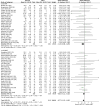Efficacy of Interval Training in Improving Body Composition and Adiposity in Apparently Healthy Adults: An Umbrella Review with Meta-Analysis
- PMID: 39003682
- PMCID: PMC11560999
- DOI: 10.1007/s40279-024-02070-9
Efficacy of Interval Training in Improving Body Composition and Adiposity in Apparently Healthy Adults: An Umbrella Review with Meta-Analysis
Abstract
Background: Although the efficacy of interval training for improving body composition has been summarized in an increasing number of systematic reviews in recent years, discrepancies in review findings and conclusions have been observed.
Objective: This study aims to synthesize the available evidence on the efficacy of interval training compared with moderate-intensity continuous training (MICT) and nonexercise control (CON) in reducing body adiposity in apparently healthy adults.
Methods: An umbrella review with meta-analysis was performed. A systematic search was conducted in seven databases (MEDLINE, EMBASE, Cochrane Database, CINAHL, Scopus, SPORTDiscus, and Web of Science) up to October 2023. Systematic reviews with meta-analyses of randomized controlled trials (RCTs) comparing interval training and MICT/CON were included. Literature selection, data extraction, and methodological quality assessment (AMSTAR-2) were conducted independently by two reviewers. Meta-analyses were performed using a random-effects model. Subgroup analyses were conducted based on the type of interval training [high-intensity interval training (HIIT) and sprint interval training (SIT)], intervention duration, body mass index, exercise modality, and volume of HIIT protocols.
Results: Sixteen systematic reviews, including 79 RCTs and 2474 unique participants, met the inclusion criteria. Most systematic reviews had a critically low (n = 6) or low (n = 6) AMSTAR-2 score. Interval training demonstrated significantly greater reductions in total body fat percent (BF%) compared with MICT [weighted mean difference (WMD) of - 0.77%; 95% confidence interval (CI) - 1.12 to - 0.32%] and CON (WMD of - 1.50%; 95% CI - 2.40 to - 0.58%). Significant reductions in fat mass, visceral adipose tissue, subcutaneous abdominal fat, and android abdominal fat were also observed following interval training compared to CON. Subgroup analyses indicated that both HIIT and SIT resulted in superior BF% loss than MICT. These benefits appeared to be more prominent in individuals with overweight/obesity and longer duration interventions (≥ 12 weeks), as well as in protocols using cycling as a modality and low-volume HIIT (i.e., < 15 min of high-intensity exercise per session).
Conclusions: This novel umbrella review with large-scale meta-analysis provides an updated synthesis of evidence with implications for physical activity guideline recommendations. The findings support interval training as a viable exercise strategy for reducing adiposity in the general population.
© 2024. The Author(s).
Conflict of interest statement
Figures





References
-
- WHO. World Health Organization Physical Activity Fact Sheet; 2016.
-
- ACSM. ACSM's Guidelines for Exercise Testing and Prescription (11th ed.): Wolters Kluwer; 2022.
-
- Guthold R, Stevens GA, Riley LM, Bull FC. Worldwide trends in insufficient physical activity from 2001 to 2016: a pooled analysis of 358 population-based surveys with 1.9 million participants. Lancet Glob Health. 2018;6(10):e1077–e86. - PubMed
Publication types
MeSH terms
LinkOut - more resources
Full Text Sources
Miscellaneous

